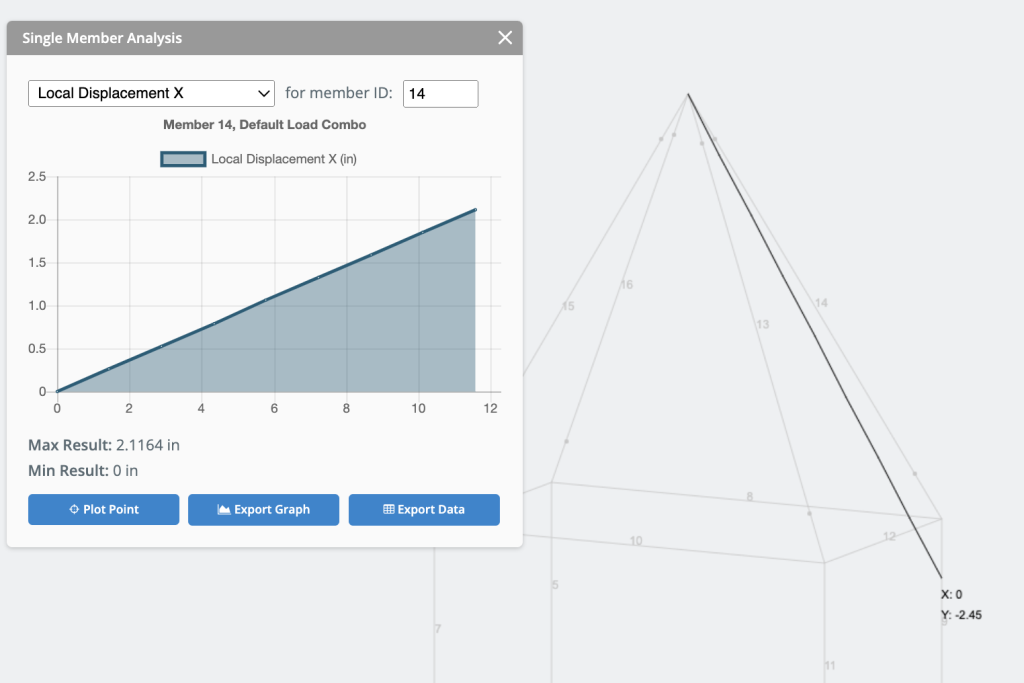鉄骨フレームをモデル化する
まずは簡単なフレームを構築してみましょう, これがケーブル要素を使用して持ち上げるものになります. 次の便利なモデリング機能を最大限に活用します。:
- ペンツール – ペンツールを使用してすばやくモデルを作成する
- マルチ編集 – CTRL を押したままマウスをドラッグして、モデルの一部を選択して複数編集します
- 検索セクション – ライブラリからセクションを数秒で追加できます, 検索を使用する
- 面積荷重 – 一方通行, 自動計算される双方向荷重および風荷重面荷重 (そして再調整してください!) メンバーの支流地域.

ケーブル要素の追加
それで、今度はケーブルを追加します. ケーブルは非線形要素です, したがって、基本的には他のメンバーを追加するのと同じ方法で追加されます. 主な違いは、ケーブルが決して圧縮されていないことです。, たわみがゼロである, ねじりまたはせん断能力 (彼らは緊張のみです) そして、多くの場合、大きな変位と非線形挙動を示します。. したがって、これらのタイプの要素の分析は、曲げ強度やその他の強度を持つ通常の鋼要素とは若干異なる扱いになります。.
ケーブル要素のモデリングは、他の要素と同じ方法で行われます。. しかしながら, 属性を割り当てるとき, あなたが選択します タイプ: ケーブル. これにより、要素にピン固定端の固定が自動的に割り当てられ、ソルバーでケーブル要素として扱われます。.

レンダラビューを開く, ケーブル要素を明確に示します (このモデルでは, セクションIDとして示されます 2).
機器やその他の負荷を加える
フレーム構造への機器荷重の適用は、通常の解析モデルと同じです。. この場合、機器負荷を適用しました。 (を使用して 双方向エリアロード) その他の死荷重 (を使用して 一方向エリアの負荷).

非線形解析を実行し、安定性の問題を修復する
通常、ケーブルは大きな荷重を受けると大きな変形を起こします。. 幾何学的非線形性により、ケーブルの変形に伴う形状の変化が考慮されます。. ケーブル応答の直線性の初期仮定 (線形静的解析と同様) 変形が大きくなると無効になります.
ケーブル要素が存在する場合は非線形解析を使用する必要があります, 非線形解析ではこれらの幾何学的変化が考慮され、より正確な結果が得られるため、. ケーブルに負荷をかけたり張ったりするとき, 各ステップの後、構造が大きく移動するため、必ずしも前と同じ位置に荷重がかかるとは限りません。.
したがって, この構造では、非線形解析を実行する必要があります。. 注意: ユーザーが選択した場合 線形静解析, 自動的に非線形解析に戻ります.

結果の確認
分析が正常に完了したら, たわみをチェックすることをお勧めします (a) 数値が妥当であることを確認し、 (b) 構造のたわみをアニメーション化して、予想どおりに変形するかどうかを確認します. ケーブル要素が正しく解決されない場合, ギザギザのたわみ曲線が表示され、ケーブルに過負荷または過負荷がかかっていることを示している可能性があります。.
正常に動作するケーブル要素は滑らかでなければなりません, たるみがあり、張力のみによる変形が見られる, サンプルモデルに見られるように:

検討する価値のあるもう 1 つの結果, はケーブル腱の軸応力です. 明らかに, ケーブルにはせん断や曲げに対する耐力がないため、, すべての力は要素内の張力を介して伝達されます. デフォルトでは、構造は材料降伏/極限強度を超える応力を強調表示します。. 独自のカスタム許容応力を入力することもできます, ストレス限界を超える要素を簡単に特定できるようにする:

考慮に値するもう 1 つの結果は、ケーブルの伸びです。. 以前レビューした変形結果と同様, ただし、この場合はケーブルがどのくらい伸びているかを調べます。. ケーブルの設計に関しては、許容できるものに制限があることがよくあります。. 変位解析は、さまざまな荷重条件下でのケーブルの動作を評価するのに役立ち、変位が許容範囲内であることを確認します。.
このため, 単一メンバー分析を使用して、オンに切り替えることができます。 局所変位X これにより、ケーブル自体の軸に沿ったケーブルのたわみの合計がわかります。. 以下の例では, ケーブルが伸びるのは 2.1164 インチ:

ケーブル解析における一般的な解決の問題
ケーブル構造が解決できない場合 (多くの場合、不安定または収束不能が原因で発生します), 確認または試行すべき一般的な事項をいくつか示します:
- 直径サイズを確認してください
- ケーブルに過負荷/過負荷がかかっていないことを確認してください
- 収束精度を下げる
- 追加のサポートを追加する
- 他のメンバーを確認してください
よくある質問
ケーブルのたるみは、ケーブルの自重と適用される荷重を考慮して考慮されます。, たわみの原因となるもの. エンジニアは通常、懸垂方程式または数値的手法を使用して、特定の荷重条件下でのケーブルの形状とたるみを決定します。.
はい, ケーブル要素にプレストレス荷重を適用できます
はい, ただし、ソフトウェアがこれを自動的に処理します. 他のソフトウェアでは, ケーブル要素は小さな要素に分割される可能性があります, 調整するのが面倒になる可能性があります. SkyCIv は要素を単一のメンバーとして保持します, ソルバー側の要素のみを分割します – モデリングと変更が簡単になる.


